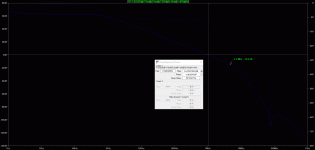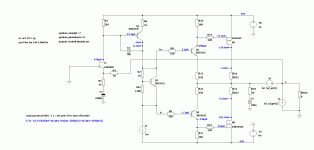You cannot relevantly assess the frequency response and stability of an amplifier by a numerical method. Why wouId you further restrict the bandwidth unnecessarily?
How else would you assess it? Frequency response is a numerical representation. Gain as a number, plotted against frequency as a number with flatness and roll-off being evaluated as numbers.
I do not dislike this topology, very unAmerican.
I don't understand this comment. Removing the double negative, you're stating you like the topology because it's un-American. What does that mean?
The pole of R2,C1 is 723KHz which is just where the flat response ends so I would say the major effect is to cancel the peaking until ~ 3MHz where the filtered response slope increases, but C1 does improve the stability.
Note that R2 is not the input impedance when connected to a pre-amp instead of an idea voltage source Vsig.
I'm too lazy to do the simulation myself but I suspect given the peaked response that the phase margin in inadequate. Filtering the input does not help stability when connected to a capacitive load.
Another potential issue if you actually built this is the CFP output lacks a Zobel network and HF impedance build-out choke.
"Restricting the bandwidth" is often improving the phase margin and stability under reactive loads. You can't really hear ultrasound but you can hear distortion due to instability, and feel the pain in your pocket book when it burns up due to ultrasonic oscillations.
Note that R2 is not the input impedance when connected to a pre-amp instead of an idea voltage source Vsig.
I'm too lazy to do the simulation myself but I suspect given the peaked response that the phase margin in inadequate. Filtering the input does not help stability when connected to a capacitive load.
Another potential issue if you actually built this is the CFP output lacks a Zobel network and HF impedance build-out choke.
"Restricting the bandwidth" is often improving the phase margin and stability under reactive loads. You can't really hear ultrasound but you can hear distortion due to instability, and feel the pain in your pocket book when it burns up due to ultrasonic oscillations.
Last edited:
I included stability indicators in the first post. I used the Tian method to evaluate them but realized I accidentally retained R1 & R2 in the path to ground instead of taking the gate of J1 straight to ground. With this corrected, stability indicators are:
Open loop gain: 63 dB
Closed loop gain: 26 dB
Unity loop gain frequency: 2.0 MHz
Phase margin: 73 degrees
Gain margin: 11 dB
ULGF looks high. Adding a 18pF cap as traditional miller compensation toes in the ULGF and smooths out the closed loop frequency response without relying on the RF input filter. Also added the Zobel output network. The results change to:
Open loop gain: 63 dB
Closed loop gain: 26 dB
Unity loop gain frequency: 1.0 MHz
Phase margin: 72 degrees
Gain margin: 15 dB
Open loop gain: 63 dB
Closed loop gain: 26 dB
Unity loop gain frequency: 2.0 MHz
Phase margin: 73 degrees
Gain margin: 11 dB
ULGF looks high. Adding a 18pF cap as traditional miller compensation toes in the ULGF and smooths out the closed loop frequency response without relying on the RF input filter. Also added the Zobel output network. The results change to:
Open loop gain: 63 dB
Closed loop gain: 26 dB
Unity loop gain frequency: 1.0 MHz
Phase margin: 72 degrees
Gain margin: 15 dB
Attachments
More thoughts: After reading more on the addition of a Zobel network to the output of the VAS for "correcting" the frequency response, I realized this likely just a alternate approach to compensation that a traditional Miller cap likely handles better in this scenario. I was resisting it because I wanted to test the concept that singleton CFA amplifiers are inherently more stable and aren't as likely to need this.
I suppose the true test would be to actual build something like this and test it with and without miller compensation.
Also, I believe Q2 as a Vbe multiplier probably isn't necessary. Lateral MOSFETs are thermally stable without need for this (or so I've read).
I suppose the true test would be to actual build something like this and test it with and without miller compensation.
Also, I believe Q2 as a Vbe multiplier probably isn't necessary. Lateral MOSFETs are thermally stable without need for this (or so I've read).
Are you excluding numbers, or just simulation?N101N said:You cannot relevantly assess the frequency response and stability of an amplifier by a numerical method.
brian92fs,
you can assess it empirically, by observation. Those numbers are misleading.
By "I do not dislike it" I meant to say "I like it." American circuit designs typically consist of op-amp inspired balanced topologies with serious instability issues that I am not especially fond of.
Phase compensation capacitors can improve stability at the expense of degraded (not corrected) high frequency performance. A Zobel network and HF choke at the output of the amplifier do not constitute an alternate approach to the Miller capacitor. None of these are generally required.
I would replace the Vbe multiplier with a resistor.
DF96,
I am not sure how to say this very concisely. I entirely reject performance measurement by the logic based formal axiomatic method which includes the enumeration of electrical quantities.
you can assess it empirically, by observation. Those numbers are misleading.
By "I do not dislike it" I meant to say "I like it." American circuit designs typically consist of op-amp inspired balanced topologies with serious instability issues that I am not especially fond of.
Phase compensation capacitors can improve stability at the expense of degraded (not corrected) high frequency performance. A Zobel network and HF choke at the output of the amplifier do not constitute an alternate approach to the Miller capacitor. None of these are generally required.
I would replace the Vbe multiplier with a resistor.
DF96,
I am not sure how to say this very concisely. I entirely reject performance measurement by the logic based formal axiomatic method which includes the enumeration of electrical quantities.
brian92fs,
you can assess it empirically, by observation. Those numbers are misleading.
By "I do not dislike it" I meant to say "I like it." American circuit designs typically consist of op-amp inspired balanced topologies with serious instability issues that I am not especially fond of.
So you like it but your not fond of it. Try reading what you post. The rest of your posts are nonsense.
I am not fond of American style, op-amp inspired, balanced topologies.
The present design is different therefore I like it.
Is there a contradiction?
I am aware that the validity of my opinion on simulation is widely denied.
I am not a professor of English. Sorry for the inconvenience.
The present design is different therefore I like it.
Is there a contradiction?
I am aware that the validity of my opinion on simulation is widely denied.
I am not a professor of English. Sorry for the inconvenience.
The accuracy of simulation is very much an issue, simulation is only a accurate as the model, but that's not what you were picked up on,
Its statements like
Its statements like
is what triggers consternation - I guess it says "I reject electronics theory", which can't really be the case can it cause you talk about electronics theory a lot. But what the hell is "the logic based formal axiomatic method" anyway?I entirely reject performance measurement by the logic based formal axiomatic method which includes the enumeration of electrical quantities.
Never heard of this notion, do you have examples of this American "style"? Do you have something against opamps?American style, op-amp inspired, balanced topologies
Oh, LOTS do, around hereDo you have something against opamps?
Numbers are good for counting objects in everyday life for which they were originally intended.
Again, a mathematical model for physical theories is not to be confused with an analytical approach utilizing techniques like Calculus of Variations, Algebraic Geometry, the Theory of Differential Equations of Infinite Order, the Concept of Function, Set Theory. The latter is close as you can get to metaphysical dogmatism.
There are many models of reality within and outside scientific orthodoxy. Concepts and views can cause elation or consternation depending on mental disposition.
Yes. I don`t use them.
Again, a mathematical model for physical theories is not to be confused with an analytical approach utilizing techniques like Calculus of Variations, Algebraic Geometry, the Theory of Differential Equations of Infinite Order, the Concept of Function, Set Theory. The latter is close as you can get to metaphysical dogmatism.
There are many models of reality within and outside scientific orthodoxy. Concepts and views can cause elation or consternation depending on mental disposition.
Do you have something against opamps?
Yes. I don`t use them.
I'm not sure you have what point you are trying to make, I see a a lot of buzzwords rather than a developed argument. You can't convince without a cogent thread of argument, and you cannot communicate complex ideas effectively without better clarity, concrete examples are really useful for this.
For instance a physical theory is a mathematical model of the world, so what is a "mathematical model for physical theories"?
For instance a physical theory is a mathematical model of the world, so what is a "mathematical model for physical theories"?
The term physical theory denotes the semantic part of the model. Mathematical expressions are just meaningless marks on the paper that need to be interpreted.
Of course, you could create a theory from scratch by writing down a set of schematic postulates and premises, calling them the law of nature, but not being "backed up" with some "verifiable"mathematical gibberish, the scientific community would dismiss it as irresponsible speculation. So for that reason, it is much better to make up some mathematical objects with supplementary posits.
Of course, you could create a theory from scratch by writing down a set of schematic postulates and premises, calling them the law of nature, but not being "backed up" with some "verifiable"mathematical gibberish, the scientific community would dismiss it as irresponsible speculation. So for that reason, it is much better to make up some mathematical objects with supplementary posits.
The term physical theory denotes the semantic part of the model. Mathematical expressions are just meaningless marks on the paper that need to be interpreted.
Of course, you could create a theory from scratch by writing down a set of schematic postulates and premises, calling them the law of nature, but not being "backed up" with some "verifiable"mathematical gibberish, the scientific community would dismiss it as irresponsible speculation. So for that reason, it is much better to make up some mathematical objects with supplementary posits.
I'm sure that in academia and literature, the meaning of words is often vague and abused, but not in science. Please read the definition of a scientific theory.
Scientific theory - Wikipedia
Numerical analysis produces almost magically accurate results repeatably because the universe is bound by mathematical relationships. Computer simulations are never perfect but such is the nature of science, indeed the universe. Minor errors are no reason to dismiss the value of relatively accurate estimates. They do regularly uncover unexpected behavior that would otherwise remain unknown until implemented in hardware. The power of computers to calculate behavior in minute bits of time produces remarkable results. The process of iterative approximation used in simulation is similar to that used by certain fractals, which further demonstrate the "magic" of mathematics.
Attractor - Wikipedia
Barnsley fern - Wikipedia
Mathematics is indeed the language of God.
Last edited:
- Status
- This old topic is closed. If you want to reopen this topic, contact a moderator using the "Report Post" button.
- Home
- Amplifiers
- Solid State
- Frequency Response Question

